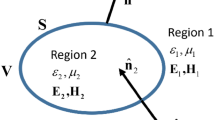Abstract
The boundary element method (BEM) is an efficient way to compute solutions of eddy current nondestructive evaluation (NDE) problems. However, in boundary element analysis of eddy currents, the computational accuracy and efficiency depend on the element discretization employed and are very sensitive to the liftoff distance and the relative geometry size between the detecting coil and object under evaluation or test. In this paper, the skin depth parameter is applied to study the element discretization effects on boundary element analysis for 3D eddy current NDE problems. The element discretization rules are concluded by conducting numerical experiments for different liftoff distances and relative probe sizes so that they can be adjusted to account for variations in these parameters, and validated against the analytical method, semi-analytical method, and experiments of some benchmark problems. With the help of the rules, the overall computational accuracy is improved while the cost is reduced for the BEM modeling of eddy current NDE problems.







Similar content being viewed by others
References
Auld, B.A., Moulder, J.C.: Review of advances in quantitative eddy current nondestructive evaluation. J. Nondestr. Eval. 18, 3–36 (1999)
Bouchala, T., Abdelhadi, B., et al.: Novel coupled electric field method for defect characterization in eddy current non-destructive testing systems. J. Nondestr. Eval. 33, 1–11 (2014)
Liu, Y.H., Liu, S., Liu, H., et al.: Pulsed eddy current data analysis for the characterization of the second-layer discontinuities. J. Nondestr. Eval. 38, 1–8 (2019)
Ma, C., Jiang, X.: A new eddy-current compensation method in MRI. PIERS Online 3, 874–878 (2007)
Cacciola, M., Morabito, F.C., Polimeni, D., et al.: Fuzzy characterization of flawed metallic plates with eddy current tests. Progress Electromagn. Res. 72, 241–252 (2007)
Li, Y., Udpa, L., Udpa, S.S.: Three-dimensional defect reconstruction from eddy-current NDE signals using a genetic local search algorithm. IEEE Trans. Magn. 40, 410–417 (2004)
Bao, Y., Liu, Z.W., Song, J.M.: Adaptive cross approximation algorithm for accelerating BEM in eddy current nondestructive evaluation. J. Nondestr. Eval. 37, 1–8 (2018)
Chew, W.C., Tong, M.S., Hu, B.: Integral Equation Methods for Electromagnetic and Elastic Waves. Morgan & Claypool, London (2008)
Hiruma, S., Otomo, Y., Igarashi, H.: Eddy current analysis of litz wire using homogenization-based FEM in conjunction with integral equation. IEEE Trans. Magn. 54, 1–4 (2017)
Schöbinger, M., Schöberl, J., Hollaus, K.: Multiscale FEM for the linear 2-D/1-D problem of eddy currents in thin iron sheets. IEEE Trans. Magn. 55, 1–12 (2018)
Lu, M.Y., Peyton, A., Yin, W.L.: Acceleration of frequency sweeping in eddy-current computation. IEEE Trans. Magn. 53, 1–8 (2017)
Moro, F., Codecasa, L.: A 3-D hybrid cell boundary element method for time-harmonic eddy current problems on multiply connected domains. IEEE Trans. Magn. 55, 1–11 (2019)
Zhang, J.M., Han, L., et al.: A new implementation of BEM by an expanding element interpolation method. Eng. Anal. Boundary Elem. 78, 1–7 (2017)
Miorelli, R., Reboud, C., Theodoulidis, T.P., Martinos, J., Poulakis, N., Lesselier, D.: Coupled approach VIM-BEM for efficient modeling of ECT signal due to narrow cracks and volumetric flaws in planar layered media. NDT&E Int. 62, 178–183 (2014)
Theodoulidis, T.P., Poulakis, N., Dragogias, A.: Rapid computation of eddy current signals from narrow cracks. NDT&E Int. 43, 13–19 (2009)
Stratton, J.A.: Electromagnetic Theory. McGraw-Hill, New York (1941)
Yang, M.: Efficient method for solving boundary integral equation in diffusive scalar problem and eddy current nondestructive evaluation. Dissertation, Iowa State University (2010)
Bao, Y., Liu, Z.W., Bowler, J.R., Song, J.M.: Multilevel adaptive cross approximation for efficient modeling of 3D arbitrary shaped eddy current NDE problems. NDT&E Int. 104, 1–9 (2019)
Bao, Y., Song, J.M.: Analysis of electromagnetic NDE modelling using Stratton–Chu formulations based fast algorithm. Philos. Trans. R. Soc. A 378, 1–15 (2020)
Bao, Y., Liu, Z.W., Song, J.M.: MACA algorithm to accelerate modeling of eddy current position sensor. Appl. Comput. Electromagn. Soc. J. 34, 1262–1265 (2019)
Rao, S.M., Wilton, D.R., Glisson, A.W.: Electromagnetic scattering by surfaces of arbitrary shape. IEEE Trans. Antennas Propag. 30, 409–428 (1982)
Antimirov, M.Y., Kolyshkin, A.A., Vaillancourt, R.: Mathematical Models for Eddy Current Testing. Les Publications CRM, Barcelona (1997)
Dodd, C.V., Deeds, W.E.: Analytical solutions to eddy-current probe-coil problems. J. Appl. Phys. 39, 2829–2838 (1968)
Theodoulidis, T.P., Bowler, J.R.: Eddy current coil interaction with a right-angled conductive wedge. Proc. R. Soc. 461, 3123–3139 (2005)
Acknowledgements
This work is sponsored in part by the National Nature Science Foundation of China for Youth under Grant 62001245, by the Natural Science Foundation of Jiangsu Province for Youth under Grant BK20200757, by the NUPTSF under Grant NY220074, by the State Key Laboratory of Millimeter Waves under Grant K202108 and by the IU Program of the Center for Nondestructive Evaluation at Iowa State University.
Author information
Authors and Affiliations
Corresponding author
Additional information
Publisher's Note
Springer Nature remains neutral with regard to jurisdictional claims in published maps and institutional affiliations.
Rights and permissions
About this article
Cite this article
Bao, Y., Gurrala, P. & Song, J. Element Discretization Effects on Boundary Element Method Modeling for Eddy Current Nondestructive Evaluation Problems. J Nondestruct Eval 40, 79 (2021). https://doi.org/10.1007/s10921-021-00812-7
Received:
Accepted:
Published:
DOI: https://doi.org/10.1007/s10921-021-00812-7




